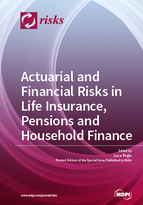Actuarial and Financial Risks in Life Insurance, Pensions and Household Finance
A special issue of Risks (ISSN 2227-9091).
Deadline for manuscript submissions: closed (15 March 2017) | Viewed by 56498
Special Issue Editor
Interests: actuarial mathematics; insurance; risk management; longevity risk; asset-liability management; financial mathematics; corporate finance
Special Issues, Collections and Topics in MDPI journals
Special Issue Information
Dear Colleagues,
The recent regulatory changes, together with the increasing awareness about the variety of sources of uncertainty that affect the assets and liabilities of insurance and pension funds, have generated increasing attention towards the insurance risk management theory and practice. Nonetheless, the ageing process and the reduction in the coverage provided by welfare states have exposed individuals to unprecedented issues regarding their demand for life insurance, health insurance, and pension and in their retirement choices.
Against this background, this Special Issue aims at highlighting high quality papers that either discuss the state of the art or propose advances in the modeling and management of actuarial and financial risks for institutions and households.
We welcome research papers, as well as reviews, related, but not limited to, the following topics:
- Managing Risks in Life Insurance Portfolios and Pension Funds
- Asset—Liability Management
- Financial innovation in insurance products and risk management solutions
- Risk sharing mechanisms
- Stochastic mortality modeling
- Lapse risk
- Investment strategies and the management of financial risks in a low interest rate environment
- The impact of regulation on risk management practices
- The consequences of ageing for individuals, companies, pension funds and states
- Saving for retirement and retirement choices
- Health insurance, long-term-care insurance and retirement
- Demographic risks in funded and unfunded pension schemes
Dr. Luca Regis
Guest Editor
Manuscript Submission Information
Manuscripts should be submitted online at www.mdpi.com by registering and logging in to this website. Once you are registered, click here to go to the submission form. Manuscripts can be submitted until the deadline. All submissions that pass pre-check are peer-reviewed. Accepted papers will be published continuously in the journal (as soon as accepted) and will be listed together on the special issue website. Research articles, review articles as well as short communications are invited. For planned papers, a title and short abstract (about 100 words) can be sent to the Editorial Office for announcement on this website.
Submitted manuscripts should not have been published previously, nor be under consideration for publication elsewhere (except conference proceedings papers). All manuscripts are thoroughly refereed through a single-blind peer-review process. A guide for authors and other relevant information for submission of manuscripts is available on the Instructions for Authors page. Risks is an international peer-reviewed open access monthly journal published by MDPI.
Please visit the Instructions for Authors page before submitting a manuscript. The Article Processing Charge (APC) for publication in this open access journal is 1800 CHF (Swiss Francs). Submitted papers should be well formatted and use good English. Authors may use MDPI's English editing service prior to publication or during author revisions.
Keywords
- life insurance
- pensions
- household finance
- actuarial and financial risks
- longevity risk
- risk sharing mechanisms
- economic consequences of ageing
- saving for retirement






